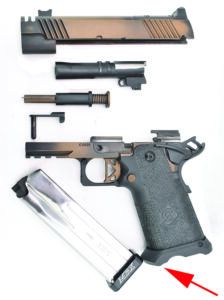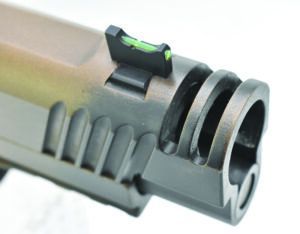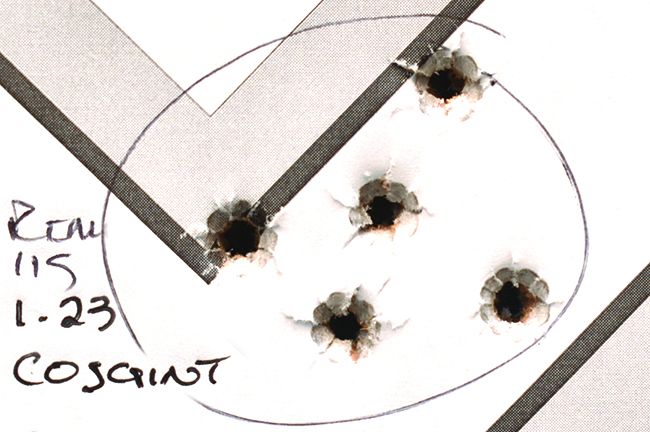Several 9mm models with double-stack magazines have really caught our eye recently. The first came from a new company called Cosaint. Our sample was a high-capacity COS21 with a Commander-length slide, an Officer’s Model–length barrel, and a bit of a compensator. It runs $2600. The next piece came from Rock Island Armory, the Model M1911 A2 FS-Tactical, $774. It uses a slightly older design, but it is built with modern production methods and comes in at an incredible price point. The third was the Springfield Armory Prodigy, $1650. Boasting features similar to other 2011-style pistols, the Prodigy gun itself is similar to a pistol we tested in the August 2023 issue, but this one was a package that comes with a Hex Dragonfly red dot, whereas the August gun was shot exclusively with a Crimson Trace CTS-1250. Because the Hex was a factory-installed optic, we wondered if it would improve the Prodigy’s downrange results beyond what the Crimson Trace dot could do.
This trio looks and feels like a 1911-style handgun, with one major difference. A 1911 in 45 ACP is a great pairing, but a standard magazine only holds seven rounds. Switching to a 9mm chambering adds a couple more rounds, but in this age of high-capacity 9mms, we want more than that.
Two Canadian gentlemen, Ted Szabo and Thanos Polyzos, brought us a great solution to the capacity problem at Para-Ordnance in the mid-1980s, with a 1911 top end mated to a double-stack-magazine-capable grip frame. The first generation of Para-Ord double-stack 1911s was bit large, but edges were rounded and bulk was trimmed, making the 2nd Gen a much more usable pistol. Also, STI (now Staccato) provided a major step in the evolution of the platform with a stainless-steel frame attached to a polymer grip module, and the 2011 was born.
Modern iterations retain the most important characteristics of Browning’s classic 1911 design, such as the 18-degree grip angle, superb trigger, and greatly improved sights, along with high-capacity magazines. Our three test guns in 9mm Luger have all these features. To see how they performed, we tested with 115-grain FMJ fodder from Winchester and Remington and a 124-grain FMJ round from Armscor. Our fourth round was a defensive choice, Hornady’s Critical Duty 124-grain +P. Function was perfect for all three of the pistols tested. We did not have a single malfunction in more than 1200 rounds fired. Here’s more on how they did.
Gun Tests Grade: A-
$2600
We are constantly on the look for new guns to test, and a company called Cosaint recently popped up on our radar. When we checked into things, we found that the corporation may be new, but their pedigree is solid. The driving force behind Cosaint is Greg Mooney. In his career, he has helped manage companies like Benchmade and Benelli USA. In his last venture, he was a member of the executive team for STI/Staccato, the Georgetown, Texas pistol builder. The Cosaint COS21 reminds us of a Staccato in some ways, but we can see Mooney’s unique input into the Cosaint design in several ways.
| Action Type | Semi auto, hammer fired |
| Overall Length | 7.8 in. |
| Overall Height | 6.0 in. |
| Maximum Width | 1.38 in. at magwell |
| Weight Unloaded | 1.7 lbs. |
| Weight Loaded | 2.4 lbs. |
| Slide Material | Steel, optics cut |
| Slide Retraction Effort | 11.5 lbs. |
| Receiver Material | Alloy, Picatinny rail |
| Finish | Burnt bronze and black Cerakote |
| Front Strap Height | 3.0 in. |
| Back Strap Height | 3.25 in. |
| Barrel Length | 4.25 in. |
| Grip Thickness (Maximum) | 1.275 in. |
| Grip Circumference | 5.8 in. |
| Magazines | Two MBX 20 round |
| Rear Sight | C&H plate with fixed rear |
| Front Sight | Green fiber optic in dovetail |
| Sight Radius | 5.25 in. |
| Trigger Pull Weight | 2.3 lbs. |
| Trigger Span | 3.1 in. |
| Safeties | Thumb levers and grip |
| Warranty | Lifetime support, no written warranty |
| Telephone | (828) 330-8214 |
| Website | CosaintArms.com |
| Made In | U.S. |
Cosaint builds Officer’s Model sized as well as Commander and Government Model length pistols. Giving Colt credit for the model names, those monikers designate 3.5-inch, 4.25-inch, and 5-inch barrels, respectively. Our test sample sports a slide/barrel combo that is available on request but is not listed on their website. Our COS21 uses the 4.25-inch Commander-length slide. Cocking serrations have been cut fore and aft, making press checks easy. One of the cool things about a 9mm 1911 versus a 45 ACP or 10mm version is the recoil spring that is required. The 9mm can use a much lighter spring, making the firearm much easier to manipulate. Racking the Cosaint’s slide is a breeze, our testers said.

Aft of the green-fiber-optic front sight, the slide has a flat top that merges smoothly into the optics plate cover made by C&H Precision Weapons (chpws.com). The system provides a milling template and various plates that accomplish what the AOS plate does on the Springfield Prodigy. The C&H slide cut provides a cross-shaped surface that matches with the reverse cut in the plate. Tighten down four screws, and the optic is solidly mounted. Of course, alternate plates can be chosen depending on your optic. Our pistol arrived without a specific optic plate, but it provided a different plate to cover the milled section. That cover plate includes a rear sight with a nice front ledge that would work for the tacticool “tack rack” that every defensive pistol absolutely must be prepared to perform. The sights also appear to be high enough to be usable with most suppressors.
Our Cosaint COS21 came with a bit of a twist on the barrel. It is a bull barrel, allowing for a bushingless design. The recoil-spring guide rod is full length and works with a reverse plug. In this case, that also means that some sort of tool must be used to capture the spring plug before the top end can be disassembled. We used a very small Allen key we keep in the toolbox just for that purpose. Simply lock the slide to the rear, insert the short leg of the Allen key into the provided hole in the guide rod, and let the slide come forward. Everything can be removed and disassembled from there. The barrel may be of standard configuration, but it is shorter than normal. Our sample arrived with a 4.25-inch slide mated to a 3.5-inch barrel. The slide doesn’t have a proper expansion chamber built into it, but it does have two slots that port out the top, acting as a simple compensator. The porting is a $150 option that adds a unique look to the pistol and softens recoil substantially.

Except for the nose end of the dust cover, the frames used on the Prodigy and the Cosaint could be twins. The Prodigy has a single groove cut in the Picatinny rail on the dust cover, and the Cosaint sports three lateral cuts. The Cosaint’s dust cover is also about 0.25 inch shorter. Once again, the slide stop sits at or below flush with the side of the frame. A left-side thumb safety is standard, with our ambi version being a $75 upgrade. The trigger was skeletonized with a triangular pattern, and it appears to be a long version. A quick measurement showed the Cosaint’s trigger face to extend about 0.150 inch further from the grip than did the Prodigy’s. That is great for those with longer fingers and easy to change if you have shorter fingers.
The grip itself is a polymer piece OEM’d by Additive America out of North Carolina. These grips aren’t molded, they’re printed. Then stippling is added, along with a removable polymer magazine well. The completed unit is very light and feels good in the hand. Did we mention the 2.3-pound trigger with very little take up or overtravel? That works for us.
The Cosaint uses MBX magazines (MBXExtreme.com) that are 126mm long, so they extend just past the bottom of the mag well. That makes them legal for USPSA Limited division, and they fed well for us. They are also available in 141.25mm, 155mm and 171.25mm lengths. And they sell for $124 each! Two are included with the pistol. Being the cheap people that we are and thinking that two different 2011-style pistols might be able to use the same magazines, we tested the magazines from Springfield in the Cosaint. They fit well, but we did not find them to work perfectly, as did the MBX mags. We would actually like to see a slightly shorter version of the magazine body, perhaps 120mm, thereby shortening the overall height for concealed carry.

Elsewhere, the sight picture was very easy to pick up on the Cosaint, especially during go-fast drills. While the thin front sight was easy to acquire, it was also too tall, with all four types of ammunition shooting 3 to 4.5 inches low at 15 yards. That, however, is a very simple fix. Remember, too, that we were using back-up iron sights (BUIS) on a pistol essentially designed for mounting an optic. We still wound up with an average group size of 1.68 inches across the four ammo types.
We also wondered about the 3.5-inch barrel/4.25-inch slide combination and whether it would be effective in reducing muzzle flip without a proper expansion chamber. We need not have worried. Muzzle flip was minimal, and the front sight just seemed to sit there during the higher-speed shooting portion of the tests. We loved the dimensions of the printed grip and the stippling. Everything was comfortable in the hand, and controls were easy to manipulate. With a $2600 retail for this model, it is easy to see who Cosaint’s competition is. And we think the Cosaint compares well to a Staccato pistol.
Our Team Said: Cosaint may be new to the firearms industry, but its management is obviously very experienced and knows how to build a good gun. We took a new Cosaint pistol, ran it hard and watched it shine. With all these positives, however, it came in second to the RIA in accuracy.
9mm Luger Range Data
Our shooters fired these pistols at American Shooting Centers in Houston. We shot them for accuracy at 15 yards by firing multiple five-shot groups from a sandbagged Caldwell Pistol Rest and a Mini DRC Fortune Cookie from Wiebad.com. We used a LabRadar chronograph to measure velocities.
| Remington 115-grain FMJ | Springfield Prodigy | Cosaint COS21 Commander | Rock Island Armory FS-Tactical |
| Average Velocity | 1147 fps | 1128 fps | 1196 fps |
| Muzzle Energy | 336 ft.-lbs. | 325 ft.-lbs. | 365 ft.-lbs. |
| Best Group | 1.49 in. | 1.52 in. | 1.07 in. |
| Average Group | 1.73 in. | 1.79 in. | 1.46 in. |
| Winchester 115-grain FMJ | Springfield Prodigy | Cosaint COS21 Commander | Rock Island Armory FS-Tactical |
| Average Velocity | 1104 fps | 1062 fps | 1159 fps |
| Muzzle Energy | 311 ft.-lbs. | 288 ft.-lbs. | 343 ft.-lbs. |
| Best Group | 1.47 in. | 1.20 in. | 1.10 in. |
| Average Group | 1.97 in. | 1.45 in. | 1.38 in. |
| Armscor 124-grain FMJ | Springfield Prodigy | Cosaint COS21 Commander | Rock Island Armory FS-Tactical |
| Average Velocity | 1060 fps | 1026 fps | 1071 fps |
| Muzzle Energy | 309 ft.-lbs. | 290 ft.-lbs. | 316 ft.-lbs. |
| Best Group | 1.73 in. | 1.50 in. | 0.96 in. |
| Average Group | 1.96 in. | 1.83 in. | 1.33 in. |
| Hornady | Springfield | Cosaint | Rock Island Armory |
| 124-grain Critical Duty | Prodigy | COS21 Commander | FS-Tactical |
| Average Velocity | 1177 fps | 1095 fps | 1223 fps |
| Muzzle Energy | 382 ft.-lbs. | 330 ft.-lbs. | 412 ft.-lbs. |
| Best Group | 0.79 in. | 1.44 in. | 1.46 in. |
| Average Group | 1.43 in. | 1.66 in. | 1.49 in. |
Drill Data (5x5x5)
Process: Fire five shots from draw at a 5-inch circle placed at 5 yards. Numbers are averages for two repetitions.| Pistol | Time to First Shot (seconds) | Split Average (seconds) | Total Time (seconds) |
|---|---|---|---|
| Springfield Prodigy | 1.36 | 0.20 | 2.160 |
| Cosaint COS21 Commander | 1.395 | 0.230 | 2.310 |
| Rock Island FS-Tactical | 1.570 | 0.264 | 2.625 |
Drill Data (5x7, A ZONE)
Process: Fire five shots from draw at A-zone plate (5-by-11 inches) at 7 yards. Numbers are averages for two repetitions.| Pistol | Time to First Shot (seconds) | Split Average (seconds) | Total Time (seconds) |
|---|---|---|---|
| Springfield Prodigy (irons) | 1.335 | 0.1990 | 2.13 |
| Springfield Prodigy (red dot) | 1.2 | 0.201 | 2.005 |
| Cosaint COS21 Commander | 1.255 | 0.205 | 2.075 |
| Rock Island FS-Tactical | 1.380 | 0.204 | 2.195 |
DRILL DATA (5x8, A ZONE)
Process: Fire five shots from draw at A-zone plate (5-by-11 inches) at 8 yards. Average of five draws from holster.| Pistol | Total Time (seconds) |
|---|---|
| Springfield Prodigy (irons) | 1.210 |
| Springfield Prodigy (red dot) | 1.298 |
| Cosaint COS21 Commander | 1.238 |
| Rock Island FS-Tactical | 1.342 |




























